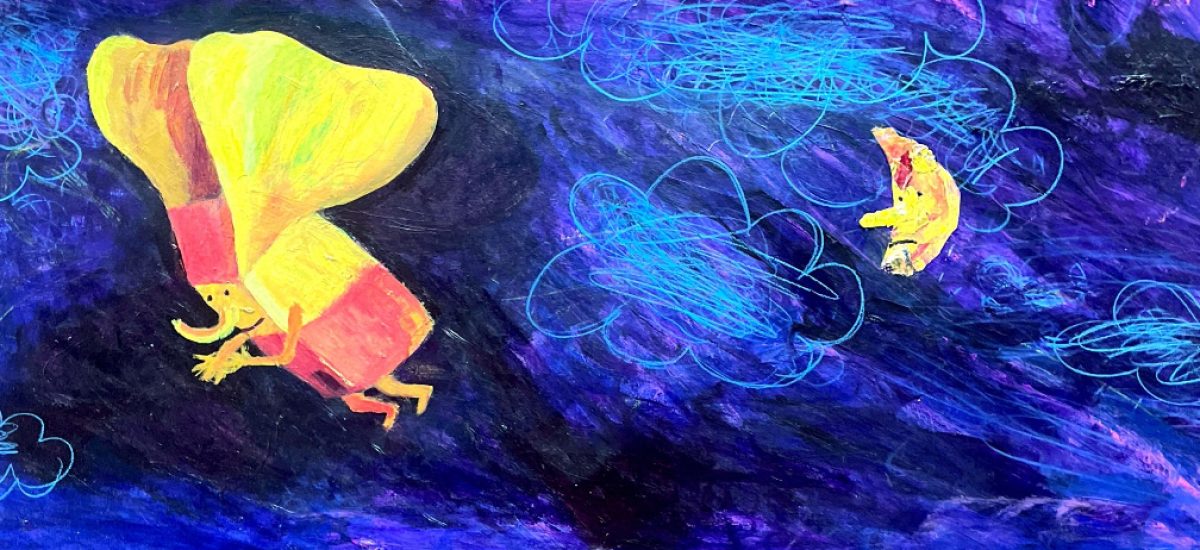Photos courtesy of Barefoot Gallery
Contemporary artist and picture book illustrator Pathum Sameera will hold an exhibition titled Mother, Junglefowl and Scarecrow at the Barefoot Gallery from June 6 to June 28. Through his captivating cartoon-like illustrations, Sameera considers the lives of women in the South’s rural agricultural landscape, playfully drawing attention to their dual roles as caretakers and providers.
Born in 1984, from the southern village Elpitiya, Pathum Sameera has built a career around personal storytelling. His art mirrors his childhood experiences, particularly the significant influence of his mother. “I come from a family where my mother was a strong character,” Sameera reflects. “She played both the mother’s and father’s roles, striving for our family’s dreams. I wanted to create a picture book in her honour.”
The exhibition title encapsulates the themes Sameera explores. “The junglefowl represents traditional male roles, while the scarecrow symbolises the youth in my village,” he explains. These elements blend reality with magic, reflecting the fantastical aspects of life in rural Sri Lanka.
His illustrations, rendered in charcoal, ink and vibrant acrylics, evoke a sense of melancholy, nostalgia and wonder. They portray village women as everyday heroes, reshaping perceptions of rural life. Sameera’s creative process is deeply intertwined with his childhood memories and the environment around him. Using contrasting mediums allows him to express different emotions. While the darker tones of charcoal and ink reflect on isolation, the colorful acrylics celebrate his mother’s vibrant spirit.
His artistic style has a storybook feel, which resonates with his background in picture book illustration. “My work is narrative driven,” he explains. “Each piece tells a story drawn from my childhood memories, particularly those involving my mother.” In developing his characters, Sameera draws from both personal experiences and literary influences. The character of his mother, for instance, is inspired not only by his own life but also by iconic literary figures. “I wanted to honour her strength,” he notes, having found a parallel in characters like Ursula from One Hundred Years of Solitude, who embodies strength within her family.
A significant focus of Sameera’s work is the evolving role of women in his village. “With many men migrating for work, women are stepping into dual roles,” he observes. “They manage households and agricultural responsibilities, often under challenging circumstances.” He highlights the struggles faced by women in rural areas, from agricultural challenges to environmental degradation. “The river I swam in as a child is now polluted due to industrialisation,” he laments.
The junglefowl in his title symbolises traditional male roles that are diminishing as men migrate abroad for better opportunities, often leaving women to navigate both domestic and economic responsibilities. “The scarecrow represents the youth who are left behind, embodying their dreams and aspirations,” Sameera explains. “These symbols reflect the changing dynamics in my community.” Migration is a recurring theme in Sameera’s work, particularly in relation to gender roles. “Many men in my village leave to seek better opportunities, often in foreign countries,” he explains. The shift has forced women to take on roles that were traditionally held by men. He emphasises that this change is not merely a shift in responsibility but a transformation of identity for many women.
Sameera’s relationship with his mother is at the heart of his work. Growing up, he saw the challenges she faced. “She taught me how to swim, took me to the river and encouraged my love for art,” he recalls. “Her strength and determination shaped who I am today.” His mother’s influence is evident in both his personal life and his artistic practice. “She was my biggest supporter,” he says. “When I wanted to buy art materials, she helped me pursue my passion.”
In his illustrations, Sameera captures the essence of these memories, portraying his mother as a figure of strength and resilience. “I want to depict her not just as a parent but as a hero in her own right,” he adds.
In addition to exploring gender roles, Sameera addresses environmental degradation in his work. “This loss of natural beauty is a source of nostalgia for me.” His illustrations often reflect this duality of beauty and loss, capturing the vibrant landscapes of his youth while also acknowledging the impact of industrialisation. “I want to evoke a sense of longing for what was once there,” he explains. “It’s important to remember our connection to nature.” In his upcoming children’s picture book titled Mother and the Secret Pond he references these memories symbolising not only the physical space of the pond but also the emotional significance it holds. Reflecting on his connection to the land, it also conveys a sense of nostalgia for the memory of learning to swim.
Looking ahead, Sameera is excited about publishing the children’s picture book as a tribute to his childhood memories and his mother’s influence.
Pathum Sameera’s exhibition showcases his creativity while also highlighting important social issues. As he invites viewers into his world, Sameera’s work serves as a powerful reminder of the everyday heroes in our communities.

